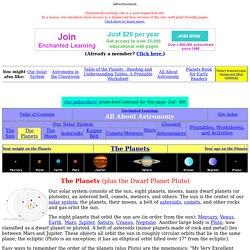

Animaniacs - Our Solar System singalong... Black hole. A black hole is defined as a region of spacetime from which gravity prevents anything, including light, from escaping.[1] The theory of general relativity predicts that a sufficiently compact mass will deform spacetime to form a black hole.[2] Around a black hole, there is a mathematically defined surface called an event horizon that marks the point of no return.

The hole is called "black" because it absorbs all the light that hits the horizon, reflecting nothing, just like a perfect black body in thermodynamics.[3][4] Quantum field theory in curved spacetime predicts that event horizons emit radiation like a black body with a finite temperature. This temperature is inversely proportional to the mass of the black hole, making it difficult to observe this radiation for black holes of stellar mass or greater. The Milky Way. Our own galaxy consists of about 200 billion stars, with our own Sun being a fairly typical specimen.

It is a fairly large spiral galaxy and it has three main components: a disk, in which the solar system resides, a central bulge at the core, and an all encompassing halo. The spiral galaxy M83 which is believed to be similar in size and shape to the Milky Way (AAO) Disk: The disk of the Milky Way has four spiral arms and it is approximately 300pc thick and 30kpc in diameter. It is made up predominantly of Population I stars which tend to be blue and are reasonably young, spanning an age range between a million and ten billion years. Bulge: Milky Way. Stars and gases at a wide range of distances from the Galactic center orbit at approximately 220 kilometers per second.

The constant rotation speed contradicts the laws of Keplerian dynamics and suggests that much of the mass of the Milky Way does not emit or absorb electromagnetic radiation. This mass has been given the name “dark matter”.[22] The rotational period is about 240 million years at the position of the Sun.[9] The Galaxy as a whole is moving at a velocity of approximately 600 km per second with respect to extragalactic frames of reference. The oldest known star in the Galaxy is at least 13.6 billion years old and thus must have formed shortly after the Big Bang.[6] Surrounded by several smaller satellite galaxies, the Milky Way is part of the Local Group of galaxies, which forms a subcomponent of the Virgo Supercluster.
Appearance[edit] The Milky Way has a relatively low surface brightness. Size and mass[edit] File:ESO-VLT-Laser-phot-33a-07.jpg. Top 10 Cool Facts about Space. Space There is still so little known about outer space by modern science, but of that little we do know, there are some extraordinarily amazing things.

This is a list of the top 10 cool facts about Space. 10. Lightweight Fact: If you put Saturn in water it would float The density of Saturn is so low that if you were to put it in a giant glass of water it would float. 9. Fact: We are moving through space at the rate of 530km a second Our Galaxy – the Milky Way is spinning at a rate of 225 kilometers per second. 8. Fact: The moon is drifting away from Earth Every year the moon moves about 3.8cm further away from the Earth. 7. Top 10 Facts About Space Food.
Space may be the final frontier, but it is also one hell of a restaurant.

Over the the past half-century, scientists and space engineers have not only been racing to get their rockets safely outside the Earth’s atmosphere, they’ve been working to ensure the menu keeps their astronauts coming back for more. While there have been all sorts of innovations and improvements, it seems now the options are better than ever, to where we might consider studying rocket science just to gain access to NASA’s kitchen. While these days it seems there is little hope in revisiting space any time soon, here are ten facts about space food, to give us food for thought as we wait until we can become weightless once more. Fact: Early Space Food Was Weird. When Yuri Gagarin become the first human being to go into outer space, he also become the first to eat and do whatever else a human must as a necessary condition of survival.
Fact: Regular Foods are Eaten in Space Now. Fact: Jerky is Huge in Space. Space. Planets - Zoom Astronomy. Advertisement.

EnchantedLearning.com is a user-supported site. As a bonus, site members have access to a banner-ad-free version of the site, with print-friendly pages.Click here to learn more. (Already a member? Click here.) The Planets (plus the Dwarf Planet Pluto) Our solar system consists of the sun, eight planets, moons, many dwarf planets (or plutoids), an asteroid belt, comets, meteors, and others.